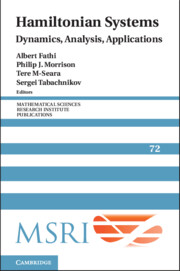Book contents
- Frontmatter
- Contents
- Denjoy subsystems and horseshoes
- Impact Hamiltonian systems and polygonal billiards
- Some remarks on the classical KAM theorem, following Pöschel
- Some recent developments in Arnold diffusion
- Viscosity solutions of the Hamilton–Jacobi equation on a noncompact manifold
- Holonomy and vortex structures in quantum hydrodynamics
- Surfaces of locally minimal flux
- A symplectic approach to Arnold diffusion problems
- Hamiltonian ODE, homogenization, and symplectic topology
Surfaces of locally minimal flux
Published online by Cambridge University Press: 10 May 2024
- Frontmatter
- Contents
- Denjoy subsystems and horseshoes
- Impact Hamiltonian systems and polygonal billiards
- Some remarks on the classical KAM theorem, following Pöschel
- Some recent developments in Arnold diffusion
- Viscosity solutions of the Hamilton–Jacobi equation on a noncompact manifold
- Holonomy and vortex structures in quantum hydrodynamics
- Surfaces of locally minimal flux
- A symplectic approach to Arnold diffusion problems
- Hamiltonian ODE, homogenization, and symplectic topology
Summary
For exact area-preserving twist maps, curves were constructed through the gaps of cantori, which were conjectured to have minimal flux subject to passing through the points of the cantorus. It was pointed out by Polterovich (1988) that these curves do not have minimal flux if there coexists a rotational invariant circle of a different rotation number, but if hyperbolic they do have locally minimal flux even without the constraint of passing through the points of the cantorus. Following the criterion of MacKay (1994) for surfaces of locally
minimal flux for 3D volume-preserving flows, I revisit this result and show that in general the analogous curves through the points of rotationally ordered periodic orbits or their heteroclinic orbits do not have locally minimal flux. Along the way, various questions are posed. Some results for more degrees of freedom are summarised.
Information
- Type
- Chapter
- Information
- Hamiltonian SystemsDynamics, Analysis, Applications, pp. 215 - 228Publisher: Cambridge University PressPrint publication year: 2024
